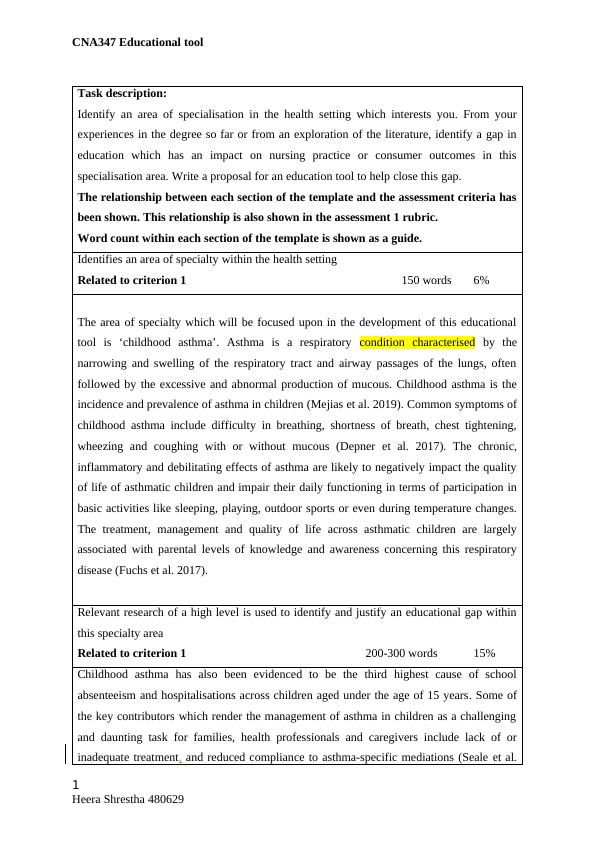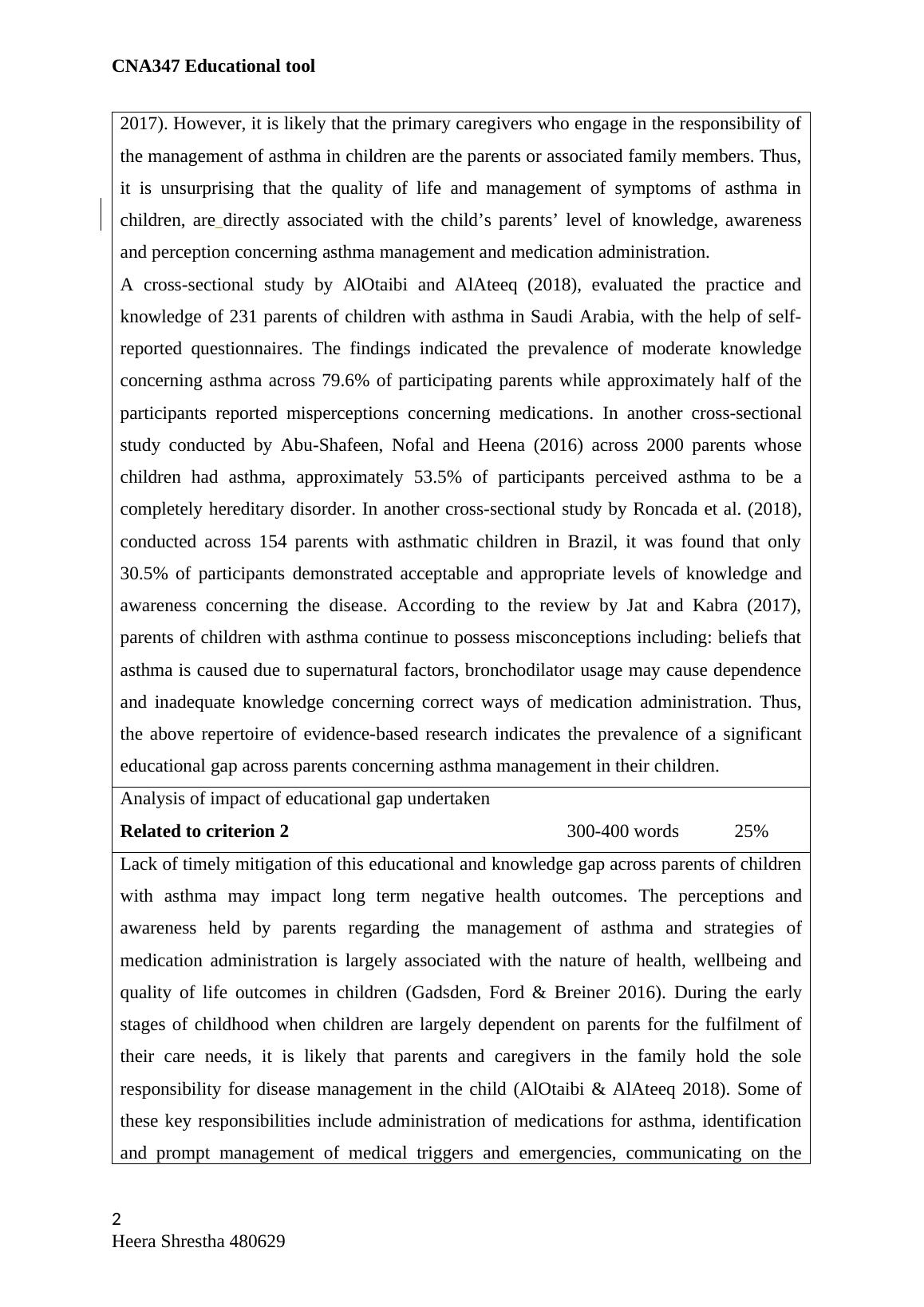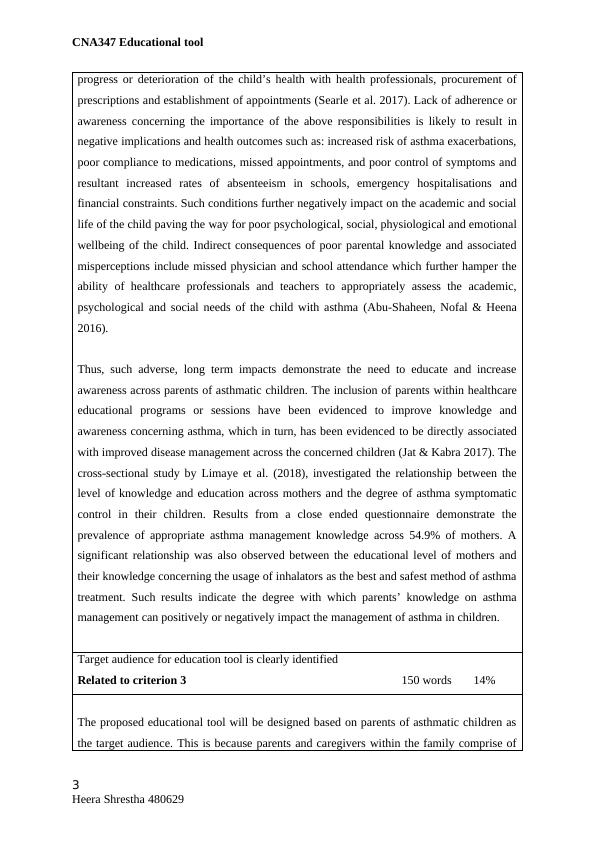CNA347 Educational Tool Analysis Assignment
Identify an area of specialisation in the health setting which interests you. From your experiences in the degree so far or from an exploration of the literature, identify a gap in education which has an impact on nursing practice or consumer outcomes in this specialisation area. Write a proposal for an education tool to help close this gap.
Added on 2022-08-26
CNA347 Educational Tool Analysis Assignment
Identify an area of specialisation in the health setting which interests you. From your experiences in the degree so far or from an exploration of the literature, identify a gap in education which has an impact on nursing practice or consumer outcomes in this specialisation area. Write a proposal for an education tool to help close this gap.
Added on 2022-08-26
Task description:
Identify an area of specialisation in the health setting which interests you. From your
experiences in the degree so far or from an exploration of the literature, identify a gap in
education which has an impact on nursing practice or consumer outcomes in this
specialisation area. Write a proposal for an education tool to help close this gap.
The relationship between each section of the template and the assessment criteria has
been shown. This relationship is also shown in the assessment 1 rubric.
Word count within each section of the template is shown as a guide.
Identifies an area of specialty within the health setting
Related to criterion 1 150 words 6%
The area of specialty which will be focused upon in the development of this educational
tool is ‘childhood asthma’. Asthma is a respiratory condition characterised by the
narrowing and swelling of the respiratory tract and airway passages of the lungs, often
followed by the excessive and abnormal production of mucous. Childhood asthma is the
incidence and prevalence of asthma in children (Mejias et al. 2019). Common symptoms of
childhood asthma include difficulty in breathing, shortness of breath, chest tightening,
wheezing and coughing with or without mucous (Depner et al. 2017). The chronic,
inflammatory and debilitating effects of asthma are likely to negatively impact the quality
of life of asthmatic children and impair their daily functioning in terms of participation in
basic activities like sleeping, playing, outdoor sports or even during temperature changes.
The treatment, management and quality of life across asthmatic children are largely
associated with parental levels of knowledge and awareness concerning this respiratory
disease (Fuchs et al. 2017).
Relevant research of a high level is used to identify and justify an educational gap within
this specialty area
Related to criterion 1 200-300 words 15%
Childhood asthma has also been evidenced to be the third highest cause of school
absenteeism and hospitalisations across children aged under the age of 15 years. Some of
the key contributors which render the management of asthma in children as a challenging
and daunting task for families, health professionals and caregivers include lack of or
inadequate treatment, and reduced compliance to asthma-specific mediations (Seale et al.
1
Heera Shrestha 480629

2017). However, it is likely that the primary caregivers who engage in the responsibility of
the management of asthma in children are the parents or associated family members. Thus,
it is unsurprising that the quality of life and management of symptoms of asthma in
children, are directly associated with the child’s parents’ level of knowledge, awareness
and perception concerning asthma management and medication administration.
A cross-sectional study by AlOtaibi and AlAteeq (2018), evaluated the practice and
knowledge of 231 parents of children with asthma in Saudi Arabia, with the help of self-
reported questionnaires. The findings indicated the prevalence of moderate knowledge
concerning asthma across 79.6% of participating parents while approximately half of the
participants reported misperceptions concerning medications. In another cross-sectional
study conducted by Abu-Shafeen, Nofal and Heena (2016) across 2000 parents whose
children had asthma, approximately 53.5% of participants perceived asthma to be a
completely hereditary disorder. In another cross-sectional study by Roncada et al. (2018),
conducted across 154 parents with asthmatic children in Brazil, it was found that only
30.5% of participants demonstrated acceptable and appropriate levels of knowledge and
awareness concerning the disease. According to the review by Jat and Kabra (2017),
parents of children with asthma continue to possess misconceptions including: beliefs that
asthma is caused due to supernatural factors, bronchodilator usage may cause dependence
and inadequate knowledge concerning correct ways of medication administration. Thus,
the above repertoire of evidence-based research indicates the prevalence of a significant
educational gap across parents concerning asthma management in their children.
Analysis of impact of educational gap undertaken
Related to criterion 2 300-400 words 25%
Lack of timely mitigation of this educational and knowledge gap across parents of children
with asthma may impact long term negative health outcomes. The perceptions and
awareness held by parents regarding the management of asthma and strategies of
medication administration is largely associated with the nature of health, wellbeing and
quality of life outcomes in children (Gadsden, Ford & Breiner 2016). During the early
stages of childhood when children are largely dependent on parents for the fulfilment of
their care needs, it is likely that parents and caregivers in the family hold the sole
responsibility for disease management in the child (AlOtaibi & AlAteeq 2018). Some of
these key responsibilities include administration of medications for asthma, identification
and prompt management of medical triggers and emergencies, communicating on the
2
Heera Shrestha 480629

progress or deterioration of the child’s health with health professionals, procurement of
prescriptions and establishment of appointments (Searle et al. 2017). Lack of adherence or
awareness concerning the importance of the above responsibilities is likely to result in
negative implications and health outcomes such as: increased risk of asthma exacerbations,
poor compliance to medications, missed appointments, and poor control of symptoms and
resultant increased rates of absenteeism in schools, emergency hospitalisations and
financial constraints. Such conditions further negatively impact on the academic and social
life of the child paving the way for poor psychological, social, physiological and emotional
wellbeing of the child. Indirect consequences of poor parental knowledge and associated
misperceptions include missed physician and school attendance which further hamper the
ability of healthcare professionals and teachers to appropriately assess the academic,
psychological and social needs of the child with asthma (Abu-Shaheen, Nofal & Heena
2016).
Thus, such adverse, long term impacts demonstrate the need to educate and increase
awareness across parents of asthmatic children. The inclusion of parents within healthcare
educational programs or sessions have been evidenced to improve knowledge and
awareness concerning asthma, which in turn, has been evidenced to be directly associated
with improved disease management across the concerned children (Jat & Kabra 2017). The
cross-sectional study by Limaye et al. (2018), investigated the relationship between the
level of knowledge and education across mothers and the degree of asthma symptomatic
control in their children. Results from a close ended questionnaire demonstrate the
prevalence of appropriate asthma management knowledge across 54.9% of mothers. A
significant relationship was also observed between the educational level of mothers and
their knowledge concerning the usage of inhalators as the best and safest method of asthma
treatment. Such results indicate the degree with which parents’ knowledge on asthma
management can positively or negatively impact the management of asthma in children.
Target audience for education tool is clearly identified
Related to criterion 3 150 words 14%
The proposed educational tool will be designed based on parents of asthmatic children as
the target audience. This is because parents and caregivers within the family comprise of
3
Heera Shrestha 480629

End of preview
Want to access all the pages? Upload your documents or become a member.
